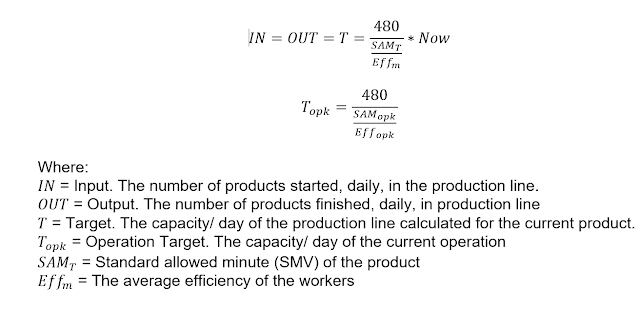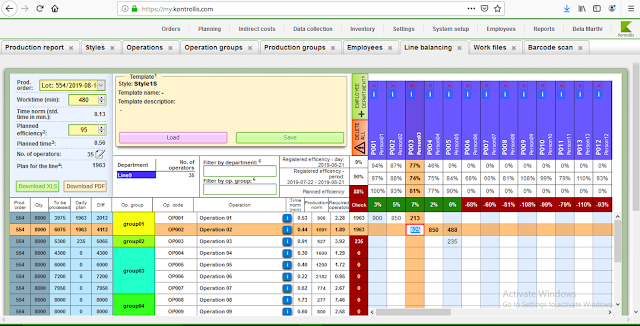
1. Funnel effect
If we imagine our production line like a tube, then each operation capacity must be close to a circle from the tube (picture 1). The radius of the circles must be similar to the radius of the tube, in order to be the line balanced. If the radius of the circles is different, our tube will become a funnel whit different forms, and the output will be the smallest circle (picture-2) of the funnel or any other form which our line will take it.

Sure, in order to balance the line, during the production, will be applied corrections like overtime and/ or supplementation of the workers from other production lines, … but all these actions will decrease real productivity and will increase the cost per minute.
2. Preparing of Production Lines activity equilibration
- Prepare the Operation breakdown and define the correct SAM (SMV)
- Measure operators’ efficiency, using, at least daily data collection ( better online data capture system)
- Define the operators’ skills matrix (the efficiency of the operators in different operations and skills)
- Define the Line Target using the above-presented formula, taking in consideration.
Operator skill matrix definition:
In the case of online data capture systems, the efficiency of the operators on different operations is given automatically. In the case of Daily data collection, skill matrix can be prepared in the SFC system using an algorithm. to make an average of the efficiency of the operator in different days when has worked a full day (or less 90- 80% from the day depending on system setup) on the analyzed operation or skill.Types of Operator skill matrix
1. Efficiency on the operation code. Examples:- Operation 1: Sleeve bottom hemming using folder
- Operation 2: Polo shirt bottom hemming before side seam, using folder
- Operation 3: Sign front placket
- Operation 4: Sign front pocket position
Define the Line Target taking into consideration the following
- The need for special machines – to not plan more persons on special machines than you have
- The 4 different efficiencies when is defined as the planning efficiency, used for target calculation.
Efficiency-2: Historical maximal efficiency of the workers (The average of maximum efficiency of the workers). This shows us what is the theoretically maximum achieved efficiency of the workers when
- The workers were planned to execute the operation where has the best skill and rhythm.
- The operators had loading all day
- When the operator had motivation
Efficiency-3: Line balancing efficiency. The resulted average planned efficiency of the workers using the under described Line balancing tool.
Efficiency-4: Realized efficiency. The average efficiency of the workers day by day after launching the current product in the line.
Important notes:
If the Line balancing efficiency is higher like the Planned efficiency, then for the same target you will need less No of workers, or with the same number of workers you must to define higher target (higher planned efficiency) if the remained worker can be integrated in Line balancing, without decreasing the efficiency of the planning.
If the Realized efficiency is lower than the planned efficiency, and if can’t grow up the operators' efficiency with workplace optimization, training.., then:
- Must be analyzed again with the under presented Line balancing interface the equilibration between operation and operators and in case to be redefined the Line target (Sure this will cause the delay of finish date)
- Must to be planned overtime in different operations in order to keep the line balanced (Sure this will cause productivity decrease and costs increasing)
3. Prepare the Line balancing sheet
In the above presented Line balancing interface
(source: Kontrollis – www.kontrollis.com), the work method is -
- Person rating on different operations. Positioning the mouse on a person “i” button, the system will offer the rating of the efficiency of the person, from the system database, on different operators and skills separately.
- Person rating on the selected operation. Positioning the mouse in one point in the operation/ operator matrix the system will show the efficiency of the selected person on the selected operation and Skill.
- Allocate gradually more with 5 – 10% like the person’s efficiency on the current operation, especially for the persons under 100% efficiency, and follow and support those persons in order to increase the efficiency.
2. Person based – Plan first the persons in the possible higher eff. Operation
3. Combined – Plan first the difficult operations, but take in consideration if one person from the rating of the current operation has higher efficiency in other operation.
- Plan the person on other operation where has higher efficiency like on the current operation only if the operations have the same difficulty levels
- Plan the person on other operation where has higher efficiency like on the current operation even the operation with higher efficiency has a lower difficulty level
Do not input more. Define the target of the line to avoid the “funnel effect”.
Assure the loading in critical points using one of the methods:

Use a similar sheet, like under presented (based on line balancing sheet) to follow, at least the critical points, min 2 times/ day (preferably each 2/3 hours).
In the above sheet, the “Plan” columns are based on Line balancing sheet, and the “Real” columns will be completed manually (if is no online data capture) during the day, in order to be visible the line balancing problem at one it appears.
Hope you find this post useful.
About the Author: This article is written by Marthi Bela. He is an ERP, PMTS specialist and Garment Industry expert.
(source: Kontrollis – www.kontrollis.com), the work method is -
- Select the manufacturing order (operations and SAM) and the production line/ group (persons) where is planned to be executed
- Set the correct target/day in the left up-side of the screen based on the formula and method presented before, defining the number of workers and the planned efficiency.
- Plan the target quantity from each operation for the correct operators, using the following instruments.
- Person rating on different operations. Positioning the mouse on a person “i” button, the system will offer the rating of the efficiency of the person, from the system database, on different operators and skills separately.
- Person rating on the selected operation. Positioning the mouse in one point in the operation/ operator matrix the system will show the efficiency of the selected person on the selected operation and Skill.
- Allocate gradually more with 5 – 10% like the person’s efficiency on the current operation, especially for the persons under 100% efficiency, and follow and support those persons in order to increase the efficiency.
Line balancing methods:
1. Operation based – Plan first the difficult operations and all the target quantity2. Person based – Plan first the persons in the possible higher eff. Operation
3. Combined – Plan first the difficult operations, but take in consideration if one person from the rating of the current operation has higher efficiency in other operation.
- Plan the person on other operation where has higher efficiency like on the current operation only if the operations have the same difficulty levels
- Plan the person on other operation where has higher efficiency like on the current operation even the operation with higher efficiency has a lower difficulty level
4. Implement and follow the Line balancing
Implement the rule in the line: INPUT = OUTPUT = TARGETDo not input more. Define the target of the line to avoid the “funnel effect”.
Assure the loading in critical points using one of the methods:
- Implement strategic inline stock before key points
- Use Jokers, which are not allocated in line balancing sheet, but are taken into consideration in the Target calculation formula!

Use a similar sheet, like under presented (based on line balancing sheet) to follow, at least the critical points, min 2 times/ day (preferably each 2/3 hours).
In the above sheet, the “Plan” columns are based on Line balancing sheet, and the “Real” columns will be completed manually (if is no online data capture) during the day, in order to be visible the line balancing problem at one it appears.
Hope you find this post useful.
About the Author: This article is written by Marthi Bela. He is an ERP, PMTS specialist and Garment Industry expert.

